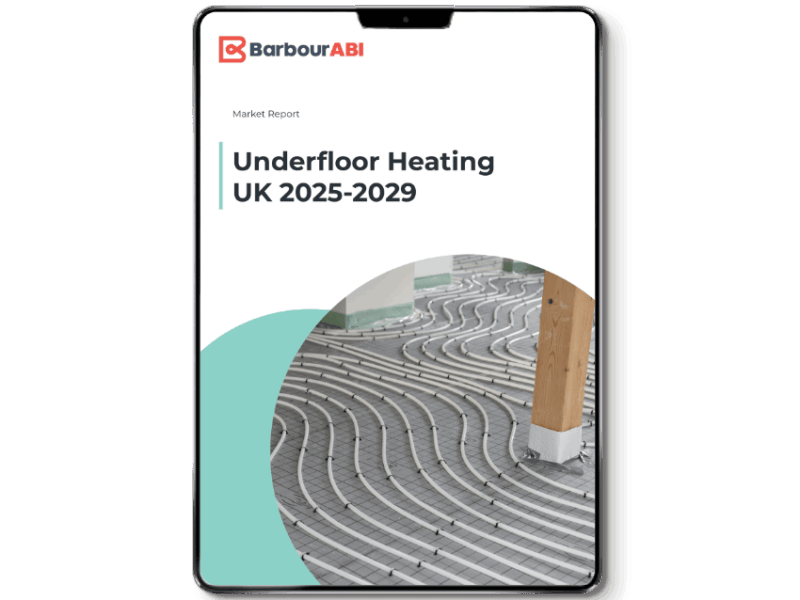Underfloor Heating Market Report – UK 2025-2029
Available as an Instant Download PDF
The Underfloor Heating Market Report UK 2025-2029 provides an in-depth analysis of a sector undergoing sustained growth and transformation, driven by regulatory change, technological innovation, and shifting consumer expectations. Covering both water-based and electric UFH systems, the report examines market performance across residential and non-residential sectors, with further breakdowns by product type, installation method, and distribution channel.
£1,499.00 Exc. VAT
The UK underfloor heating (UFH) market continues to experience steady growth, driven by increasing demand for energy-efficient, low-carbon heating solutions across both residential and non-residential sectors. With strong alignment to government policy goals—such as net zero carbon emissions by 2050 and the Future Homes Standard—UFH is becoming a preferred choice in new builds and gaining traction in retrofit projects.
Water-based systems dominate the market, particularly in new homes, while electric systems are widely used in renovation and smaller-scale projects due to ease of installation. The market is also being shaped by advances in smart controls, low-profile systems, and integration with renewable technologies like heat pumps. Despite challenges such as installation costs and skills shortages, the outlook remains positive, with underfloor heating now firmly established as a mainstream, future-ready heating solution in the UK.
Report Overview
Market Growth: The UK underfloor heating market has a projected growth of 6% in 2025, making UFH one of the strongest-performing segments in the HVAC sector.
Product Breakdown: Water-based UFH systems dominate the market, accounting for 59% of the value, mainly driven by new build demand. Electric UFH systems hold a 41% share, with a strong uptake in the retrofit market.
Application Sectors: The residential sector represents 67% of the market, driven by growing homeowner interest, regulatory compliance, and compatibility with hard floor finishes. The non-residential sector (33%) includes applications in education, healthcare, commercial offices, and leisure facilities.
Installation Types: New build installations make up the majority of the market (75–85% by value), but retrofit installations are growing, especially for electric systems, aided by low-profile and overlay solutions that reduce disruption.
Leading Suppliers: The top four companies—Polypipe, Wavin, Warmup, and RWC—account for 46% of the market by value. The rest of the market is fragmented, with numerous suppliers competing across product types and sectors.
Challenges: Barriers to wider adoption include installation costs, particularly in retrofits, and a shortage of trained installers, although product innovations and growing DIY interest are helping to ease these constraints.
Market Size
The UK underfloor heating market was valued at approximately £213 million at manufacturers’ selling prices (MSP) in 2024, with growth expected to reach £226 million in 2025, reflecting continued demand across both residential and non-residential sectors.
Market Analysis
Overall, the market is transitioning from niche to mainstream, with underfloor heating becoming an increasingly integral part of the UK’s sustainable building landscape.
Characterized by strong structural growth, underpinned by a combination of regulatory pressure, technological advancements, and a shift in consumer preference toward low-carbon, energy-efficient solutions. The market benefits from increasing alignment with wider policy goals such as net zero carbon emissions, and legislation like Part L of the Building Regulations and the Future Homes Standard, which are accelerating the shift away from traditional heating systems.
The sector remains product-diverse and application-sensitive, with water-based systems dominating new build developments, while electric systems are more prevalent in retrofit and refurbishment projects due to their speed and simplicity of installation. While new build activity accounts for the majority of UFH installations, innovation in low-profile and overlay systems is beginning to unlock new opportunities in the retrofit segment.
The supply chain is fragmented but evolving, with a core group of major players holding significant market share, while a growing number of online retailers, specialist suppliers, and hybrid installers are reshaping how UFH systems are specified and procured.
Skills shortages in installation and rising input costs pose challenges, but are being addressed through greater standardisation, modular system design, and increasing availability of training and support services.
Forecast
The UK underfloor heating (UFH) market is poised for continued growth, with projections indicating a 6% increase in value to £226 million at manufacturers’ selling prices (MSP) in 2025.
Key Companies Mentioned in the Report
The UK UFH market features a mix of established manufacturers and emerging players:
Polypipe: A leading provider of UFH systems, known for its comprehensive product range and strong market presence.
Wavin Offers a variety of UFH solutions, catering to both residential and commercial applications.
Warmup: Specializes in electric UFH systems, with a focus on innovation and user-friendly controls.
RWC Provides a range of UFH products, emphasizing ease of installation and reliability.
Others: Companies like Nu-Heat, Rehau, Danfoss, Uponor, and Gaia Climate Solutions contribute to the market’s diversity, offering specialized products and services across various UFH segments
Table of Contents
1. INTRODUCTION
- 1.1 Introduction
- 1.2 Sources of Information
- 1.3 Market Definition
- 1.4 Abbreviations
2. MARKET SUMMARY
- 2.1 Market size
- 2.2 Market overview
- 2.3 Market splits
- 2.3.1 Market mix by product category
- 2.3.2 Market mix by application type
- 2.3.3 Market mix by type of installation
3. MARKET INFLUENCES AND DRIVERS
- 3.1 Main market influences and drivers
- 3.2 Political influences and drivers
- 3.3 Economic influences and drivers
- 3.4 Social influences and drivers
- 3.5 Technological influences and drivers
- 3.6 Legal influences and drivers
- 3.7 Environmental Influences and drivers
4. END USE SECTORS
- 4.1 End-use mix by application
- 4.2 Residential sector prospects and influences
- 4.2.1 Overview
- 4.2.2 New build starts and completions
- 4.2.3 Completions by type of dwelling
- 4.2.4 Self-build market
- 4.2.5 Affordable housing
- 4.2.6 Residential RMI activity
- 4.2.7 Conservatories & glazed extensions
- 4.2.8 Garden buildings for ‘all year use’
- 4.3 Non-residential sector prospects and influences
- 4.3.1 Overview
- 4.3.2 Health construction
- 4.3.3 Education construction
- 4.3.4 Other construction sectors
5. MARKET SUB SECTORS
- 5.1 Water-based UFH systems
- 5.1.1 Water-based UFH systems – market summary
- 5.1.2 Water-based UFH systems – application mix
- 5.1.3 Water-based UFH systems – end users
- 5.1.4 Water-based UFH systems – suppliers / key players
- 5.1.5 Water-based UFH systems – company market shares and profiles
- 5.2 Electric UFH products – market size
- 5.2.1 Electric UFH systems – market summary
- 5.2.2 Electric UFH systems – application mix
- 5.2.3 Electric UFH systems – end users
- 5.2.4 Electric UFH systems – suppliers / key players
- 5.2.5 Electric UFH systems – company market shares and profiles
6. DISTRIBUTION
- 6.1 Market structure
- 6.2 Channel shares by supplier
- 6.2.1 Residential
- 6.2.2 Non-residential
- 6.3 Key company profiles
- 6.3.1 Merchants
- 6.3.2 Plumbing and heating distributors
- 6.3.3 Electrical wholesalers
- 6.3.4 Home improvement multiples
- 6.3.5 Online retailers
- 6.3.6 Tile specialists
- 6.3.7 Underfloor heating contractors
7. MARKET FORECASTS
- 7.1 10-year market overview
- 7.2 Future market prospects and influences
- 7.3 Trade & Business Investment
Charts and Tables Included in the Report
CHART 1: UK UNDERFLOOR HEATING MARKET BY VALUE (£M MSP) 2020 – 2025
TABLE 2: THE BENEFITS AND LIMITATIONS OF UNDERFLOOR HEATING
TABLE 3: UNDERFLOOR HEATING SUPPLIERS % MARKET SHARES BY VALUE 2024
CHART 4: UK UNDERFLOOR HEATING MARKET MIX BY PRODUCT CATEGORY 2024 (% BY VALUE)
CHART 5: UK UNDERFLOOR HEATING MARKET MIX BY TYPE OF APPLICATION 2024 (% BY VALUE)
CHART 6: UK UNDERFLOOR HEATING MARKET MIX BY TYPE OF INSTALLATION 2024 (% BY VALUE)
TABLE 7: UK UNDERFLOOR HEATING MARKET PESTLE SUMMARY 2024/2025
TABLE 8: KEY ECONOMIC VARIABLES 2021 – 2025
TABLE 9: UK WETROOM MARKET BY VALUE (£M MSP) 2020-2024
TABLE 10: UK FLOORCOVERINGS MARKET BY VALUE (£M MSP) 2020-2024
CHART 11: UK FLOORCOVERINGS MARKET MIX BY PRODUCT CATEGORY 2024 (% BY VALUE)
CHART 12: UK SMART HEATING CONTROLS MARKET (£M MSP), 2020-2025
TABLE 13: UK HEAT PUMP MARKET BY VALUE (£M MSP) 2020-2024
CHART 14: UK UNDERFLOOR HEATING MARKET MIX BY TYPE OF APPLICATION 2024 (% BY VALUE)
CHART 15: RESIDENTIAL CONSTRUCTION OUTPUT (GREAT BRITAIN) BY VALUE (£ BILLION AT CURRENT PRICES) 2019 – 2024
TABLE 16: GB RESIDENTIAL STARTS AND COMPLETIONS (ENGLAND, WALES, AND SCOTLAND) (000’S) 2019 – 2026
TABLE 17: NEW BUILD COMPLETIONS MIX BY TYPE OF DWELLING (HOUSES & FLATS) AND BY NUMBER OF BEDROOMS IN ENGLAND, 2018/2019 TO 2023/2024 – % OF DWELLINGS
TABLE 18: UK SELF-BUILD MARKET BY NUMBER OF COMPLETIONS, 2019-2024
CHART 19: AGE OF HOUSING STOCK IN ENGLAND & WALES BY DATE OF BUILD 2023 – %
TABLE 20: UK RESIDENTIAL PROPERTY TRANSACTIONS VALUED AT £40K OR ABOVE 2020-2024
TABLE 21: UK RESIDENTIAL CONSERVATORY & GLAZED EXTENSIONS MARKET, 2019 – 2024
TABLE 22: UK GARDEN BUILDINGS FOR ‘ALL YEAR USE’ MARKET 2019 – 2024
CHART 23: NON-RESIDENTIAL CONSTRUCTION OUTPUT (£BN AT CURRENT PRICES) 2020 – 2029
CHART 24: NON-RESIDENTIAL NEW CONSTRUCTION OUTPUT ANALYSIS BY SECTOR 2024 AND 2029 (% BY VALUE)
CHART 25: TOTAL CONSTRUCTION OUTPUT IN THE HEALTH SECTOR (£BN AT CURRENT PRICES) 2020 – 2029
CHART 26: TOTAL CONSTRUCTION OUTPUT IN THE EDUCATION SECTOR (£BN AT CURRENT PRICES) 2020 – 2029
CHART 27: WATER-BASED UFH MARKET BY VALUE (£M MSP) 2020 – 2025
CHART 28: WATER-BASED UFH MARKET MIX BY TYPE OF APPLICATION 2024 (% BY VALUE)
TABLE 29: WATER-BASED UFH SUPPLIERS % MARKET SHARES BY VALUE 2024
TABLE 30: WAVIN LTD
TABLE 31: POLYPIPE LTD
TABLE 32: RELIANCE WORLDWIDE CORPORATION UK LTD
TABLE 33: NU-HEAT UK LTD
TABLE 34: PURMO GROUP UK LTD
TABLE 35: REHAU LTD
CHART 36: ELECTRIC UFH MARKET BY VALUE (£M MSP) 2020 – 2025
CHART 37: ELECTRIC UFH MARKET MIX BY TYPE OF APPLICATION 2024 (% BY VALUE)
TABLE 38: ELECTRIC UFH SUPPLIERS % MARKET SHARES BY VALUE 2024
TABLE 39: WARMUP PLC
TABLE 40: DANFOSS LTD
TABLE 41: GLEN DIMPLEX UK LTD
TABLE 42: VIESSMANN LTD
CHART 43: DISTRIBUTION STRUCTURE FOR UNDERFLOOR HEATING PRODUCTS
CHART 44: DISTRIBUTION OF UNDERFLOOR HEATING PRODUCTS TO END USERS 2024
CHART 45: DISTRIBUTION OF RESIDENTIAL UNDERFLOOR HEATING PRODUCTS BY CHANNEL, 2024
TABLE 46: TRAVIS PERKINS TRADING COMPANY LTD
TABLE 47: WOLSELEY UK LTD
TABLE 48: STARK BUILDING MATERIALS UK LTD
TABLE 49: SCREWFIX DIRECT LTD
TABLE 50: EDMUNDSON ELECTRICAL LTD
TABLE 51: CITY ELECTRICAL FACTORS LTD (CEF)
TABLE 52: REXEL UK LTD
TABLE 53: B & Q LTD
TABLE 54: WICKES GROUP PLC
TABLE 55: THE UNDERFLOOR HEATING STORE LTD
TABLE 56: TOPPS TILES UK LTD
CHART 57: UK PLUMBING AND HVAC CONTRACTORS REGISTERED FOR VAT / PAYE BY EMPLOYMENT SIZE BAND, 2024
TABLE 58: ENTERPRISES REGISTERED FOR VAT INVOLVED IN PLUMBING & HVAC INSTALLATION BY TURNOVER SIZE BAND, 2024
TABLE 59: UK UNDERFLOOR HEATING MARKET BY VALUE (£M MSP) 2020 – 2029
Regulatory and Policy Drivers
The Future Homes Standard (from 2025) and updates to Part L of the Building Regulations are pushing the industry toward low-carbon heating systems.
These regulations are accelerating the transition from gas boilers to UFH-compatible solutions like air and ground source heat pumps.
Energy Efficiency and Net Zero Goals
Government targets for net zero carbon emissions by 2050 are creating a favourable environment for UFH as an energy-efficient solution.
UFH systems, especially when paired with renewable energy sources, help reduce a building’s carbon footprint.
Growth in New Build and Retrofit Markets
UFH is increasingly specified in new build residential and commercial projects, where it can be seamlessly integrated.
The retrofit sector is also growing, aided by low-profile and overlay systems that are easier and less disruptive to install.
Smart Heating and Home Automation
There is rising demand for smart controls and zoned heating systems, which offer better energy management and user convenience.
UFH systems are being integrated with smart home platforms, enhancing control, efficiency, and appeal to tech-savvy homeowners.
Consumer Lifestyle and Interior Design Trends
UFH complements the trend toward open-plan living and minimalist interiors, as it removes the need for visible radiators.
It’s also compatible with popular flooring materials like tile, stone, and engineered wood, supporting its adoption in modern homes.
Legislative and Regulatory Influence
Future Homes Standard (2025)
Set to take effect in 2025, the Future Homes Standard mandates that all new homes must be built with low-carbon heating systems and achieve at least 75–80% lower carbon emissions compared to those built under 2013 standards.
This regulation is driving adoption of UFH, particularly water-based systems paired with heat pumps, which meet the low-temperature heating criteria outlined in the standard.
Part L of the Building Regulations (2022 Uplift)
Part L focuses on the conservation of fuel and power in buildings and sets new minimum standards for energy efficiency.
Net Zero Carbon Target (2050)
The UK government’s commitment to achieving net zero emissions by 2050 underpins much of the current and future legislative pressure on the heating sector.
Boiler Ban and Phase-Out of Fossil Fuels
Although not a blanket ban, there are plans to phase out gas boilers in new homes from 2025 and potentially retrofit markets beyond 2030.
SAP and EPC Ratings
Energy Performance Certificates (EPCs) and the Standard Assessment Procedure (SAP) are being updated to reflect real-world energy use more accurately.
Product Category
Water-Based UFH Systems (Hydronic)
These systems circulate warm water through a network of pipes laid beneath the floor surface. They are typically used in:
• New build residential properties
• Larger retrofits
• Commercial buildings
Electric UFH Systems
Electric systems use heated cables, mats, or foils installed beneath the floor surface to radiate heat upward.
They are typically used in:
• Retrofit applications
• Single rooms (e.g. bathrooms, kitchens, extensions)
• DIY installations
Residential Sector
The residential market remains the dominant end-use sector, accounting for 67% of UFH market value in 2024. It includes:
New build homes: Major growth driver, especially for water-based systems integrated into low-carbon heating strategies.
Retrofit projects: A growing segment, supported by the development of low-profile electric and overlay systems that minimise disruption.
Non-Residential Sector
The non-residential sector accounts for approximately 33% of market value, with significant uptake across:
• Healthcare (hospitals, care homes)
• Education (schools, colleges, universities)
• Commercial offices and retail
• Leisure and recreation (gyms, spas, hotels)
• Industrial facilities and distribution centres
Self-Build and Custom Housing
This sub-sector continues to show growth as self-builders favour UFH for energy efficiency, design flexibility, and comfort. Many projects integrate UFH with heat pumps, solar PV, and smart home technology.
Distribution and Supplier Analysis
The UK underfloor heating (UFH) market features an increasingly diverse and evolving distribution structure, reflecting the wide range of end-users and growing variety of routes to market. While direct-to-consumer (DTC) models remain prominent—particularly in the non-residential and new build sectors—the overall market is shifting towards more indirect distribution, particularly within the residential and retrofit segments.
A growing number of builders’ merchants, plumbers’ merchants, electrical wholesalers, tiling retailers, and DIY/home improvement multiples are now actively supplying UFH systems. In addition, renewable energy installers and online retailers have expanded their presence, offering not only products but also add-on services such as design, installation, and maintenance.

Paired Report Discount
Save £250 for every two reports you buy
Discount applied in basket
Frequently bought together

Trusted by industry leaders
For more detailed requests speak to our research experts directly
By using this form you agree that your data will be processed and protected in line with our Privacy Policy.
Research you can depend on
Our reports go deeper to give you the insights needed to make your next strategic move.
- Detailed assessment of the market – analysis of the market structure and recent developments within the market.
- Market prospects up to 4 years – market value, opportunities, impact of socioeconomic events and regulatory developments.
- Detailed information – market size, influences, market factors and key players.
- Analysis by product group – market size, product mix, sector trends etc.





